|
On the 15th January 2023 one of the largest individual sunspots of Solar Cycle 25 rotated into view on the eastern limb of the Sun. It’s designated number was AR 3190 and it was crackling with M-class and X-class solar flares!
0 Comments
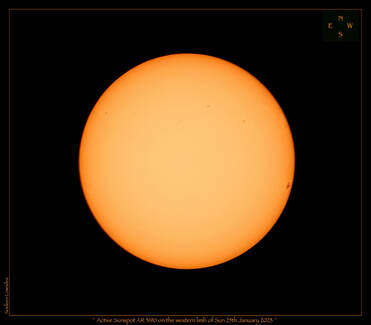 I only just managed to capture these images of the Sun before the clouds started rolling in showing those two large sunspot areas AR3190 & 3192. You can see a lot of activity surrounding them as they both neared the western limb of the Sun; there are also a lot of little sunspots sprinkling right across the northern solar surface. The (Ha) images were taken with a Lunt 60mm solar telescope with a Canon 700D fitted with a 2x Barlow lens, exposure time was 1/320th second and ISO200. Twenty images captures and stacked in RegiStax6 and processed in PS CS4. The white light image was taken with a Canon 70D camera and Canon 100-400mm lens with 2x teleconverter making a focal length of 1280mm, a glass solar filter was fitted to lens for safe viewing and imaging. That large sunspot AR 3190 is now nearing the western limb of the Sun and is not as large but still very active and could pose quite a risk with X-ray solar flares.
https://www.spaceweather.com/glossary/flareclasses.html https://hesperia.gsfc.nasa.gov/sftheory/flare.htm All those other smaller sunspots have dispersed and the other side of the solar surface is looking very quite and spotless, hopefully tomorrow I’ll be able to set up the LUNT solar telescope to take some picture in (Ha). There may be some active prominences on the limb…how exciting :-) Images taken with a Canon 70D camera and a Canon 100-400mm lens with a 2x teleconverter attached making a focal length of 1280mm. An Orion glass solar filter was fitted to the lens for safe imaging and viewing of the Sun. Twenty images were captured with 1/500th second exposures and ISO100, pictures were stacked in RegiStax6 and processed in PS CS4. 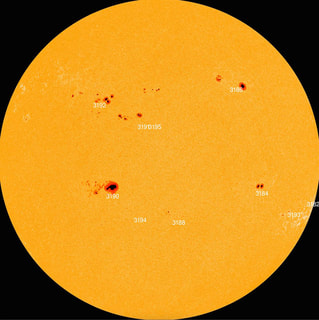 Credit: SDO/HMI Credit: SDO/HMI Not only is that large sunspot AR 3190 moving toward the centre of the Sun many other sunspots have developed on the solar surface. It’s the most I’ve seen in a very long time :-) I get this information from the Spaceweather.com website where the daily Sun is posted from NASA’s Solar Dynamic Observatory at: https://sdo.gsfc.nasa.gov It helps me to orientate my solar images and to name them their numbers on the image. Images taken with a Canon 70D camera and a Canon 100-400mm lens with a 2x teleconverter attached making a focal length of 1280mm. An Orion glass solar filter was fitted to the lens for safe imaging and viewing of the Sun. Twenty images were captured with 1/500th second exposures and ISO100, pictures were stacked in RegiStax6 and processed in PS CS4. Sunspot AR 3190 is the largest individual sunspot of Solar Cycle 25 and is now four to five times the size of the diameter of our Earth and it’s crackling with M-class and X-class solar flares!
What does it take to be X-class at: https://svs.gsfc.nasa.gov/10833 Images taken with a Canon 70D camera and a Canon 100-400mm lens with a 2x teleconverter attached making a focal length of 1280mm. An Orion glass solar filter was fitted to the lens for safe imaging and viewing of the Sun. Twenty images were captured with 1/500th second exposures and ISO100, pictures were stacked in RegiStax6 and processed in PS CS4. 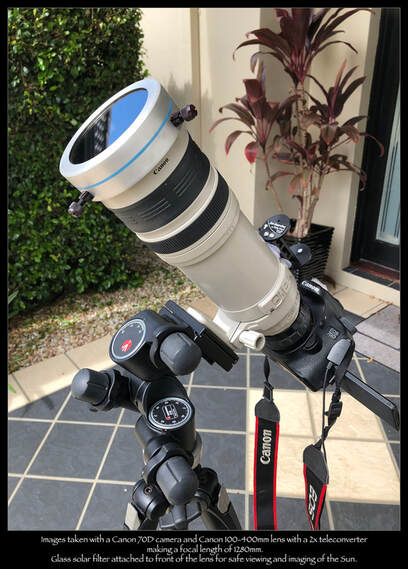 On the 15th January 2023 one of the largest individual sunspots of Solar Cycle 25 rotated into view on the eastern limb of the Sun. It’s designated number was AR 3190 and it was crackling with M-class and X-class solar flares! Because of all the cloudy weather we’ve had here on the east coast of Australia this is the first image of the Sun that I’ve been able to take for 2023. Images taken with a Canon 70D camera and Canon 100-400mm lens with a 2x teleconverter making a focal length of 1280mm. Glass solar filter attached to front of the lens for safe viewing and imaging of the Sun. I’ve taken a photo of my quick set-up gear for taking solar images in visible light (white light). It comprises of a Canon 70D camera fitted with a Canon 100-400mm lens with a 2x teleconverter lens attached making a focal length of 1280mm because the Canon 70D has a cropped sensor by 1.6. (Math: 400x2=800 x1.6 = 1280mm) WARNING: Never look at the Sun unless you have a solar filter on your lens! There is an Orion glass solar filter fitted on the end of the lens to observe 99.9% light and heat from Sun to safely view and take images…you must have a solar filter! Another very helpful and must have is a Televue Sol Searcher which attached to the top of the lens and has a hole that lines up the Sun and projects it onto a screen, this way you don’t have to look up at the Sun…not necessary but ever so helpful J You must have you camera set-up on a camera tripod or tracking tripod to stabilise your images at these high magnifications and last of all but not least is a cable release cable. This is so you are not touching the camera and can do fast shots one after another. Other camera models may have this feature built into the camera have a look in your camera manual. The Sun is a fascinating object to look at and take images of but you must be very careful to observe it safely by using solar filters on your lenses and telescopes. Stardust Junior Astronomy Club at Runaway Bay Library on the Gold Coast.
https://www.goldcoast.qld.gov.au/libraries/Whats-on Yippee! After three years away because of Covid The Stardust Junior Stardust Club will start up again on Thursday the 2nd February 2023 from 4-5pm For budding little astronomers between the ages of 6-12 years Thank you to Gold Coast Libraries. Please scan the QR code on the flyer or go to the link below to book, as bookings are essential. See you there for lots of space fun... Noeleen :-) |
AuthorI just love being under the heavens, come on a journey with me and I’ll share some of the amazing wonders of the Universe with you. Noeleen :-) Archives
June 2024
Categories
All
|
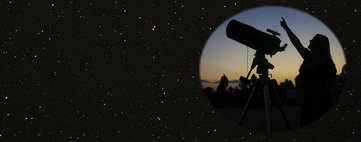
For all current observations of the night sky please go to my Astro Blog:
http://www.mystardustobservatory.com/astro-blog
Copyright information:
You are welcome to use my images for educational and private use, please credit me.
If you need higher resolution images then please contact me on my contact page, thank you.
http://www.mystardustobservatory.com/astro-blog
Copyright information:
You are welcome to use my images for educational and private use, please credit me.
If you need higher resolution images then please contact me on my contact page, thank you.
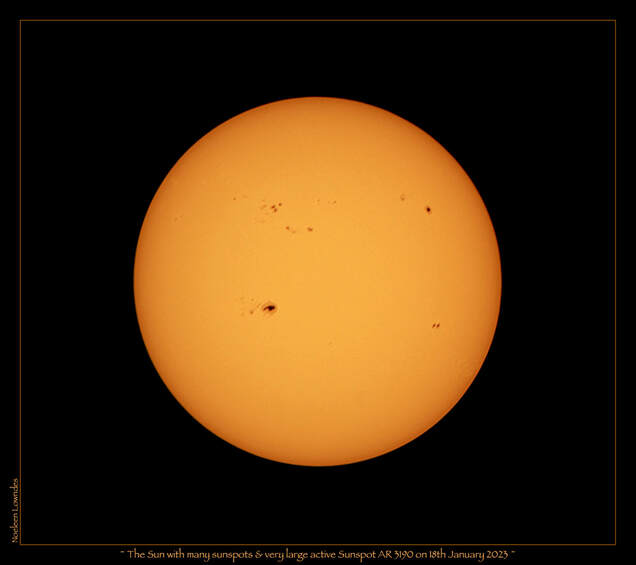
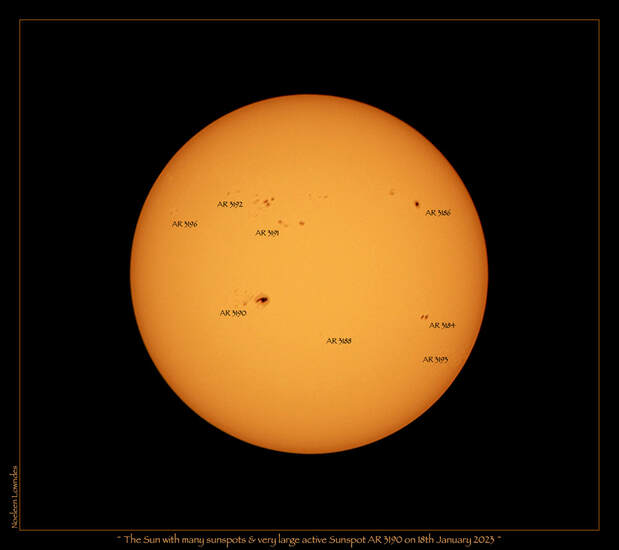
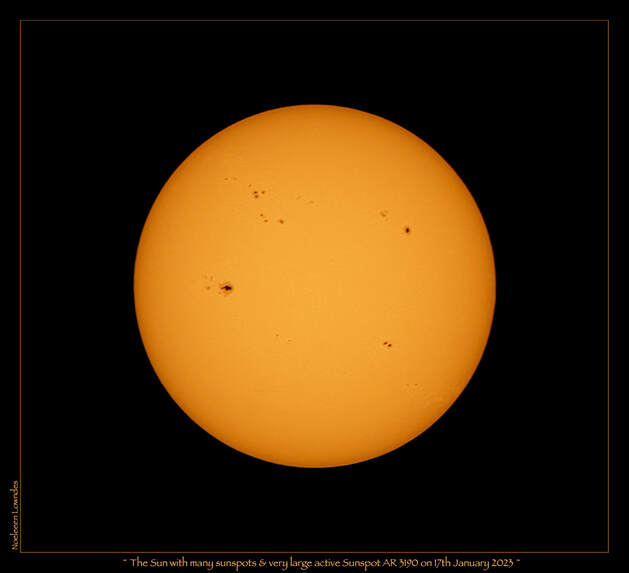
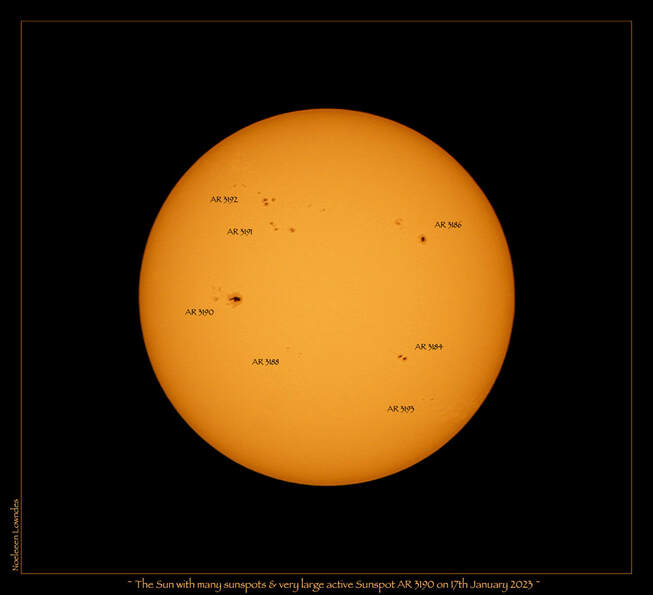

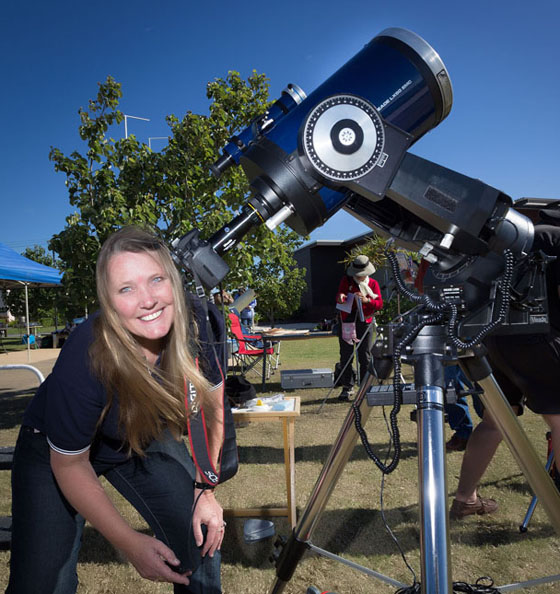
 RSS Feed
RSS Feed